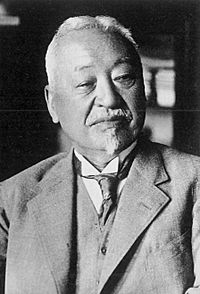Masuda Takashi facts for kids
Quick facts for kids
Masuda Takashi
益田 孝 |
|
|---|---|

Masuda Takashi
|
|
| Born | November 12, 1848 Sado Island, Niigata prefecture, Japan
|
| Died | December 28, 1938 (aged 90) |
| Nationality | Japanese |
| Occupation | Founder of Mitsui Bussan and Nihon Keizai Shimbun |
Baron Masuda Takashi (born November 12, 1848 – died December 28, 1938) was an important Japanese businessman. He was also an investor and collected many artworks. Masuda was a leading entrepreneur during the Meiji period, Taishō period, and early Shōwa period in Japan.
He helped turn the Mitsui company into a huge business group called a zaibatsu. He did this by creating a major trading company called Mitsui Bussan. Masuda also started a newspaper, the Chugai Shōgyō Shimpō. This newspaper is now known as the Nihon Keizai Shimbun.
Contents
Early Life and Education
Masuda Takashi was born on Sado Island. This island is now part of Niigata Prefecture in Japan.
His father worked for the Tokugawa shogunate, which was the military government of Japan. His father was an official in Hakodate. Masuda's family had worked for the government for many generations. His father's job involved dealing with foreigners and trade. This was important because Japan was ending its isolation policy, known as sakoku.
Becoming an Interpreter
During this time, the American Consulate General Townsend Harris was in Japan. He was based at Zenpuku-ji in Azabu. At just 14 years old, Takashi worked there as an interpreter. This means he helped people speak to each other when they spoke different languages.
Studying Western Culture
In 1863, Masuda traveled to Europe with the Second Japanese Embassy. This trip was to discuss opening ports in Japan. Even though the trip did not fully succeed, Masuda was very impressed by Western culture. When he returned home, he studied English. He attended the Hepburn School, which later became Meiji Gakuin University.
Building a Business Empire
After the Meiji Restoration in 1871, Masuda got a job at the Ministry of Finance. He had good connections with Inoue Kaoru, a powerful figure. Masuda's younger sister, Nagai Shigeko, went to the United States in 1871. She, along with Tsuda Umeko, dedicated her life to improving education for women in Japan.
Leading Mitsui Trading Company
Masuda later became the Master of the Mint, but he left this job in 1873. In 1874, he helped start a trading company called Senshu Kaisha in Tokyo. He was the vice president, with support from Inoue.
In 1876, at 29 years old, Masuda became the president of Mitsui Trading Company (Mitsui Bussan Kaisha). He played a huge part in making Mitsui a powerful zaibatsu. Mitsui quickly became a leader in Japan's trade. They exported silk, cotton, coal, and rice. They also imported industrial goods and weapons.
Expanding Mitsui's Reach
Masuda worked with the government to buy the Miike coal mines. He got them at a very good price. This mine became part of a new company, Mitsui Mining Company, in 1889. This company was very important to Mitsui's growth. In the 1890s, Mitsui expanded into machinery, textiles, and paper industries.
In 1900, Masuda started the Taiwan Sugar Corporation. This marked Mitsui's expansion into Japanese overseas colonies. By the 1910s, Mitsui was Japan's largest general trading company. It handled almost 20% of all of Japan's trade.
Later Life and Legacy
Masuda officially retired in 1913. After retiring, he spent a lot of his time on the Japanese tea ceremony. He had homes in Odawara and Kamakura. He often hosted tea ceremonies there.
He started one of the two most important annual tea ceremonies in Japan. Even today, only economically powerful people are invited to these events. In 1918, he was given the title of baron (danshaku). His son, Masuda Tarokagyu, became a famous writer of plays.
Masuda Takashi passed away in 1938. His grave is at the Buddhist temple of Gokoku-ji in Tokyo.
See also
 In Spanish: Masuda Takashi para niños
In Spanish: Masuda Takashi para niños

